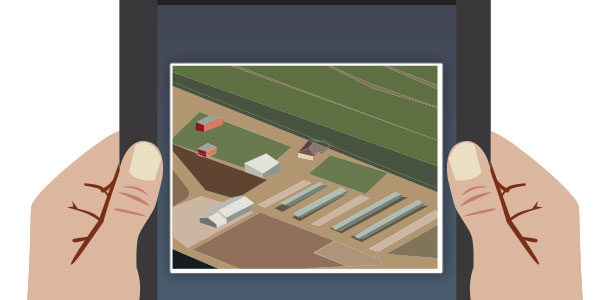For Dr. Luke Miller, the farm manager at Vierra Dairy Farm in Hilmar, California, the answer is yes; cloud-based data storage is right for their dairy. Although the process is not complete yet, Miller has been busy transitioning the 2,000-cow dairy over from DairyComp to the cloud.
Currently, they milk twice a day through an antiquated parlor, but they are looking to expand the operation. In order to grow, they needed to make some changes. Cloud-based data storage is helping them do just that.
“What interested me in this and what kind of brought us to the cloud was a little bit of involvement in new technology as we get ready to further advance this dairy and push forward into some new technology with a new milk barn, with new freestall barns,” Miller says.
Switching to the cloud enabled Miller to be able to step off the farm while still keeping tabs on it. From his phone he can access any records or check in on any animal or pen he wants to at any time. Additionally, the dairy’s two owners, both of whom are off-site, can check in and monitor what is happening on their dairy without actually going there.
Not only is this data accessible from anywhere with a connection, but it has enabled them to get broader data.
“One of the big goals for us was to get broader data,” Miller says. “Having a ready-fit income over feed cost and a financial tag associated with a lot of the dairy’s data was a big deal for us. To be able to not just understand that there’s 400 cows in every pen and we’re missing two on our inventory, but so what? What is the cost of having cows out of every string that are in the wrong string?”
Miller goes over the data at least twice a month, once with the employees he oversees on the farm and once with the owners of the dairy. The cloud has made it easy for him to do this and to use it as a means to educate them about the operation.
For instance, since he knows from the data exactly what it costs them if someone accidentally mixes the wrong feed or puts the wrong cow in the wrong pen, he can take that and tell his bosses what the bottom line is and the employee what that mistake cost them.
One of their biggest challenges with this so far has been employee education and participation. Switching systems requires a certain amount of training, understanding and often a change in the process.
Getting employees out of their ruts and ways of doing things and making them not only understand why, but be onboard with it, was a bit of a roadblock. He didn’t just want them to use the program; he wanted them to understand why they were using it so they used it like he wanted them to.
However, switching to the cloud isn’t necessarily as big of a jump as some people seem to think. Producers shouldn’t be focusing on it being a cloud, Miller says; they should see it as a different computer screen, a different program. That’s it.
A good connection with the cloud is another challenge that needs to be addressed. Employees either need to be on a cell phone plan or a tablet, and a good Wi-Fi system needs to be in place. This is a must. Miller says that actually helped him with the switch since some of his employees were pretty happy to have him hand them a tablet for work.
With the cloud, he is able to evaluate them more easily. Those who excel at their work stand out and seem efficient, which encouraged their employees to use it. Miller is able to give them more specific parameters and compare their work from month to month.
Before, if they lost six calves, they simply knew they lost six calves. Now they can track how many calves they lost and how much medicine they used. These details are important when evaluating their procedures and discussing where improvements can be made.
The cloud is also more user-friendly than their previous system. Before, a major component of obtaining the necessary data was knowing what questions to ask. This system is much more intuitive.
Data security is one concern Miller says many producers have. However, he trusts the system, and producers need to understand that this is their data, and it is only a free exchange of information if they would like it to be. On the flip side, this isn’t someone’s social security number.
If someone wants to know what’s in their TMR or what the cows in pen three are doing, he really isn’t worried about that. While he does not want the information out there for anyone to see, it doesn’t hurt him or the operation if someone else obtained that information.
These concerns and challenges are not specific to Miller either. Experts David Cook, a partner at Bovi Sync, and Philip Dukas, associate director of Dairy Records Management Services, have seen similar challenges for producers they work with.
Some additional challenges they have seen are putting together a data management plan that works for their operation, seeing the bigger picture and making the transition as smooth as possible for employees.
Producers also need to understand that this is a commitment, not a one-week trial. In fact, Cook says it will take between three and six months of recording data before the producer will really start to benefit from it.
Producers also need to be confident the data they are collecting is accurate, says Dukas. Data should be accurate – not somewhat accurate. If that is the case, then they need to find a way to fix it.
“The only way to make progress is to measure what you’re doing and for the quality of your data to not just be a ‘somewhat’,” Dukas says. “If you asked your employees: ‘Is your paycheck accurate?’ And if they responded, ‘It’s somewhat accurate,’ by that point you’d have a mutiny on your hands. That’s just one element of the farm.”
The reality is: Switching how an operation collects, stores and accesses its data is going to have its difficulties, just like any other change in procedure would. It’s going to require time and training. However, it may be worth it in the long run. For Miller, it certainly is. That is a decision every producer needs to make for their own operation.PD
Illustration by Corey Lewis.

Jenna Hurty
Editor
Progressive Dairyman






